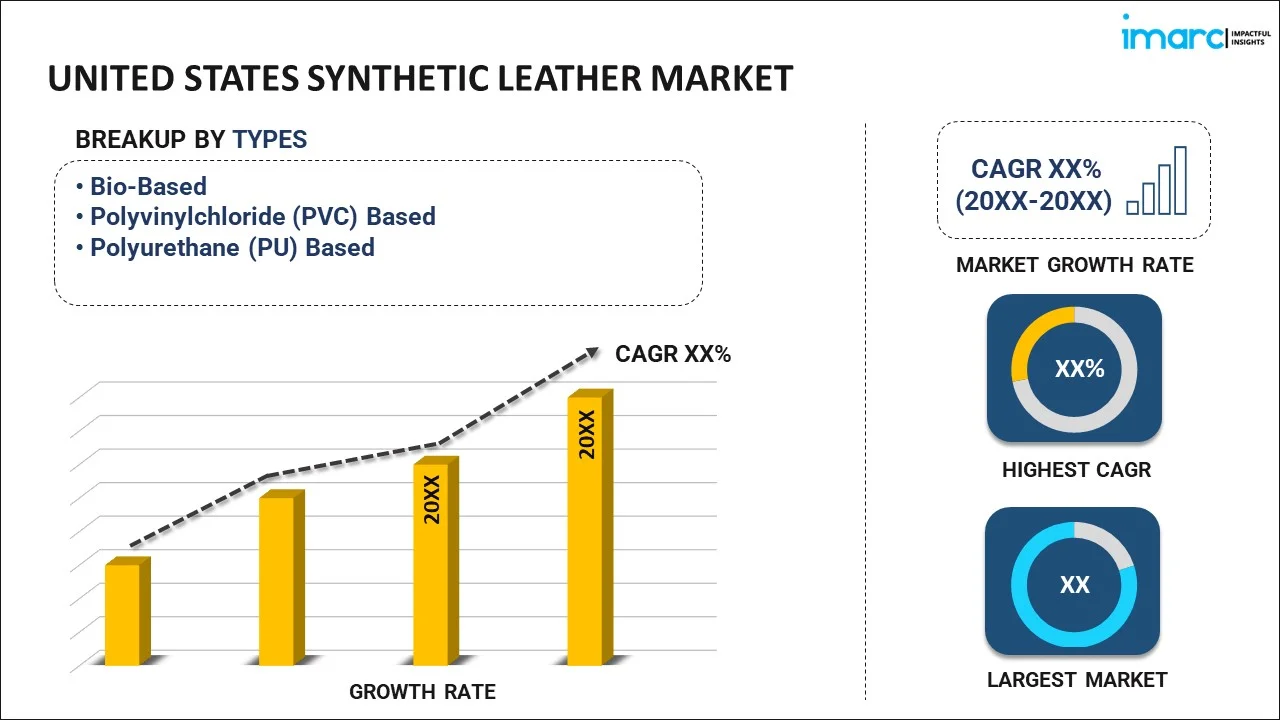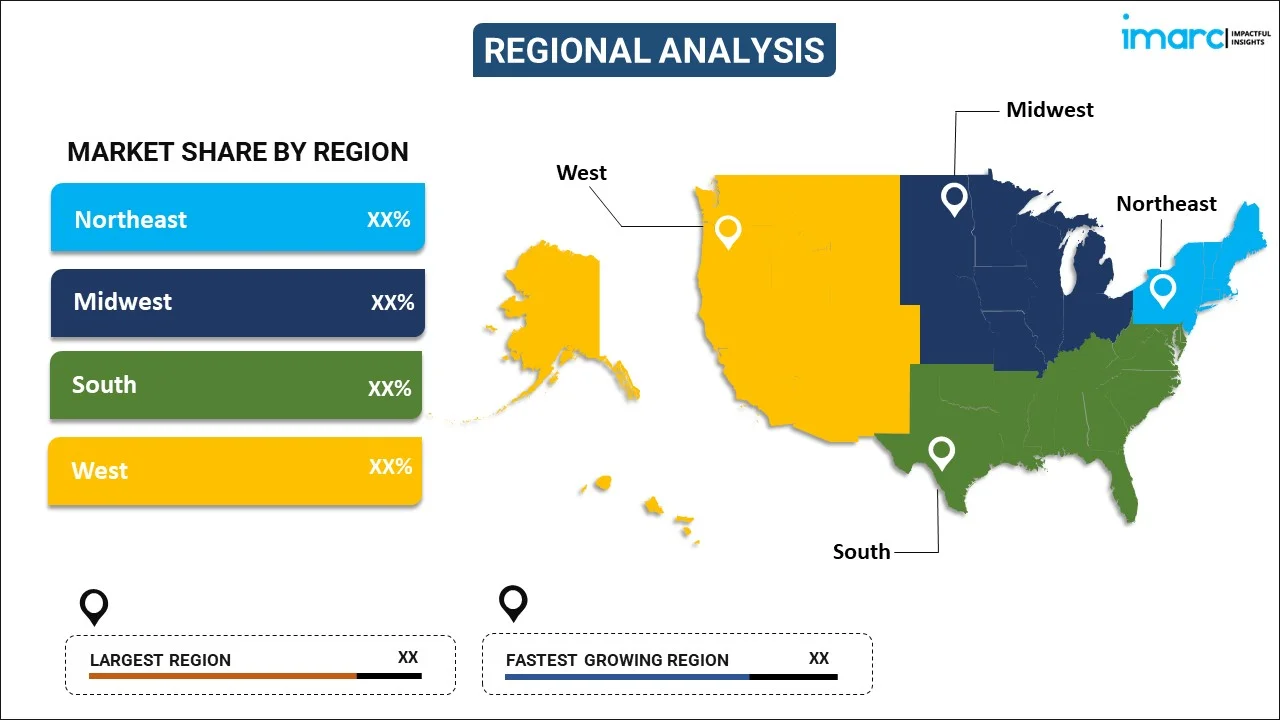
United States Synthetic Leather Market Report by Type (Bio-Based, Polyvinylchloride (PVC) Based, Polyurethane (PU) Based), Application (Clothing, Bags, Shoes, Purses and Wallets, Accessories, Car Interiors, Belts, Sports Goods, and Others), End Use Industry (Footwear, Furniture, Automotive, Textile, Sports, Electronics, and Others), and Region 2024-2032
Market Overview:
United States synthetic leather market size is projected to exhibit a growth rate (CAGR) of 7.44% during 2024-2032. The continuous advancements in manufacturing processes and technologies, which have enhanced the quality and performance of synthetic leather, are driving the market.
|
Report Attribute
|
Key Statistics
|
|---|---|
|
Base Year
|
2023 |
|
Forecast Years
|
2024-2032
|
|
Historical Years
|
2018-2023
|
| Market Growth Rate (2024-2032) | 7.44% |
Synthetic leather, also known as faux leather or artificial leather, is an artificial alternative to traditional animal-derived leather. It is crafted from various synthetic materials, primarily polyurethane (PU) or polyvinyl chloride (PVC), offering a cruelty-free and more sustainable option. The manufacturing process involves layering these materials to mimic the texture and appearance of genuine leather. Synthetic leather has gained popularity due to its lower cost, versatility, and reduced environmental impact compared to traditional leather production, which involves raising livestock and significant resource consumption. In recent years, efforts have been made to enhance the eco-friendliness of synthetic leather by exploring alternative materials and refining production methods. As technology advances and consumer preferences shift towards sustainable options, synthetic leather continues to evolve as a viable and ethical alternative in the fashion and upholstery industries.
United States Synthetic Leather Market Trends:
The synthetic leather market in the United States is experiencing robust growth, driven by several key factors. To begin with, the increasing awareness regarding environmental sustainability has propelled the demand for synthetic leather as a viable alternative to traditional animal-derived leather. Moreover, stringent regulations pertaining to animal welfare and the adverse environmental impacts of leather production have steered consumers and industries towards synthetic alternatives. Furthermore, technological advancements in the manufacturing processes of synthetic leather have significantly enhanced the quality and durability of these materials. This has resonated well with consumers seeking high-performance, long-lasting products, thus fostering market expansion. Additionally, the fashion industry's evolving preferences and the demand for cruelty-free and vegan products have created a substantial market space for synthetic leather. The versatility of synthetic leather in terms of design, color, and texture, coupled with its cost-effectiveness, has also contributed to its widespread adoption across various end-use industries. In conclusion, a combination of ethical considerations, technological progress, and shifting consumer preferences are serving as powerful drivers for the synthetic leather market in the United States, shaping it into a dynamic and rapidly growing sector with promising prospects for the future.
United States Synthetic Leather Market Segmentation:
IMARC Group provides an analysis of the key trends in each segment of the market, along with forecasts at the country level for 2024-2032. Our report has categorized the market based on type, application, and end use industry.
Type Insights:

- Bio-Based
- Polyvinylchloride (PVC) Based
- Polyurethane (PU) Based
The report has provided a detailed breakup and analysis of the market based on the type. This includes bio-based, polyvinylchloride (PVC) based, and polyurethane (PU) based.
Application Insights:
- Clothing
- Bags
- Shoes
- Purses and Wallets
- Accessories
- Car Interiors
- Belts
- Sports Goods
- Others
A detailed breakup and analysis of the market based on the application have also been provided in the report. This includes clothing, bags, shoes, purses and wallets, accessories, car interiors, belts, sports goods, and others.
End Use Industry Insights:
- Footwear
- Furniture
- Automotive
- Textile
- Sports
- Electronics
- Others
The report has provided a detailed breakup and analysis of the market based on the end use industry. This includes footwear, furniture, automotive, textile, sports, electronics, and others.
Regional Insights:

- Northeast
- Midwest
- South
- West
The report has also provided a comprehensive analysis of all the major regional markets, which include the Northeast, Midwest, South, and West.
Competitive Landscape:
The market research report has also provided a comprehensive analysis of the competitive landscape in the market. Competitive analysis such as market structure, key player positioning, top winning strategies, competitive dashboard, and company evaluation quadrant has been covered in the report. Also, detailed profiles of all major companies have been provided.
United States Synthetic Leather Market Report Coverage:
| Report Features | Details |
|---|---|
| Base Year of the Analysis | 2023 |
| Historical Period | 2018-2023 |
| Forecast Period | 2024-2032 |
| Units | Billion US$ |
| Scope of the Report | Exploration of Historical and Forecast Trends, Industry Catalysts and Challenges, Segment-Wise Historical and Predictive Market Assessment:
|
| Types Covered | Bio-Based, Polyvinylchloride (PVC) Based, Polyurethane (PU) Based |
| Applications Covered | Clothing, Bags, Shoes, Purses and Wallets, Accessories, Car Interiors, Belts, Sports Goods, Others |
| End Use Industries Covered | Footwear, Furniture, Automotive, Textile, Sports, Electronics, Others |
| Regions Covered | Northeast, Midwest, South, West |
| Customization Scope | 10% Free Customization |
| Report Price and Purchase Option | Single User License: US$ 3699 Five User License: US$ 4699 Corporate License: US$ 5699 |
| Post-Sale Analyst Support | 10-12 Weeks |
| Delivery Format | PDF and Excel through Email (We can also provide the editable version of the report in PPT/Word format on special request) |
Key Questions Answered in This Report:
- How has the United States synthetic leather market performed so far and how will it perform in the coming years?
- What has been the impact of COVID-19 on the United States synthetic leather market?
- What is the breakup of the United States synthetic leather market on the basis of type?
- What is the breakup of the United States synthetic leather market on the basis of application?
- What is the breakup of the United States synthetic leather market on the basis of end use industry?
- What are the various stages in the value chain of the United States synthetic leather market?
- What are the key driving factors and challenges in the United States synthetic leather?
- What is the structure of the United States synthetic leather market and who are the key players?
- What is the degree of competition in the United States synthetic leather market?
Key Benefits for Stakeholders:
- IMARC’s industry report offers a comprehensive quantitative analysis of various market segments, historical and current market trends, market forecasts, and dynamics of the United States synthetic leather market from 2018-2032.
- The research report provides the latest information on the market drivers, challenges, and opportunities in the United States synthetic leather market.
- Porter's five forces analysis assist stakeholders in assessing the impact of new entrants, competitive rivalry, supplier power, buyer power, and the threat of substitution. It helps stakeholders to analyze the level of competition within the United States synthetic leather industry and its attractiveness.
- Competitive landscape allows stakeholders to understand their competitive environment and provides an insight into the current positions of key players in the market.
Need more help?
- Speak to our experienced analysts for insights on the current market scenarios.
- Include additional segments and countries to customize the report as per your requirement.
- Gain an unparalleled competitive advantage in your domain by understanding how to utilize the report and positively impacting your operations and revenue.
- For further assistance, please connect with our analysts.
 Inquire Before Buying
Inquire Before Buying
 Speak to an Analyst
Speak to an Analyst
 Request Brochure
Request Brochure
 Request Customization
Request Customization




.webp)




.webp)












